Sharing Pediatric HIV Experience with the Third World
AIDS therapy is complex, with more than 20 antiretroviral drugs in use in the United States. The extensive knowledge required to use these drugs effectively was not gained overnight. It has been more than 20 years since AIDS burst onto the scene, and new drugs have been added at a pace of about one or two a year, allowing physicians in the U.S. and other developed nations the time to learn how to use each one appropriately. Until quite recently, almost none of these drugs were available in poor countries, but with antiretrovirals now being introduced to resource-poor areas of the world, a crash course in HIV treatment is needed so they can be used correctly.
Philip LaRussa, MD, Andrea Jurgrau, CPNP, and their colleagues at Columbia University Medical Center have taken on the task of sharing their extensive experience in pediatric HIV medicine with healthcare workers in poorer countries. Dr. LaRussa, professor of clinical pediatrics, and Ms. Jurgrau, pediatric nurse practitioner, have worked with HIV-infected children since the start of the AIDS epidemic, and they have a wealth of experience and a willingness to share it with the world.
Sharing Hard-Won Experience
"From my standpoint, it's gratifying to be able to do something with all this experience that we've accumulated over the years," Dr. LaRussa said. "We've got a decent handle on what's going on here in the United States. But there, they are dealing with all the problems of how you practice medicine in a resource-poor setting without every sophisticated lab test and radiologic test that you can order here without even thinking about how much money it costs."
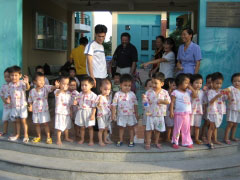
Ms. Jurgrau agreed. "I've been doing this work for a long time, and because things have been going well with pediatric HIV here in America, it was obvious that our expertise was needed elsewhere. We had learned a lot, and done a lot here, that could be useful in other countries at this point."
When Jane Aronson, MD, an international adoption medicine specialist and founder and director of the Worldwide Orphans Foundation (WWO) in New York City, asked Dr. LaRussa and his colleagues whether they would be willing to share their knowledge with healthcare workers at her orphanage-based HIV clinics in the third world, they were glad to help. [see the related article, Caring for AIDS Orphans: Jane Aronson and the WWO].
"Jane trained with us in pediatric infectious disease," Dr. LaRussa said. "A couple of years ago, she came to us and said, as a result of her own experiences adopting children in Vietnam and Ethiopia, she saw that there was a need for training for people who are taking care of HIV-infected kids in orphanages in those countries." He continued, "We wanted to concentrate on the orphans, because in many countries orphans are at the bottom of the barrel. They are the ones that are most likely to get neglected when it comes to care."
At the time, physicians in third-world countries were expecting to shortly receive antiretroviral drugs, but they had little in the way of training to use them effectively. Dr. LaRussa said that "these people in resource-poor countries are getting everything at once, essentially being asked to accumulate 25 years of experience, all in a relatively short period of time." As he sees it, "There's a lot of accumulated experience in the United States that needs to be transferred over to where it needs to be used now, so that they don't end up with the same sort of problems that we had because we were giving the drugs one by one."
According to Dr. LaRussa, it's clear that HIV medicine will need to be practiced differently in poorer countries dealing with the HIV epidemic. "The model in the United States is that HIV-infected children and adults are cared for by HIV specialists," Dr. LaRussa said. "That model is not going to work in countries that have huge numbers of HIV-infected patients. There are just not enough specialists to go around. Care is going to have to be provided by general medical doctors, so you've got to train on different levels and provide more background material than you would with somebody who's already had some specialty training."
As in most areas of medicine, good clinical care requires more than applying a formula or a recipe. This kind of information cannot simply be put into a table or an algorithm and be followed by rote. "Unfortunately, medical care is a little bit more complicated than that," Dr. LaRussa said. "There's a decent amount that needs to be known about adverse events, what to expect, how quickly people respond, and what drugs not to use together. What do you do when there's a rash or some other problem, do you stop the drugs? If you have to stop the drugs, what's the right way to do it? There's also the minutiae of medicine that is hard to put in a table and tell people exactly what to do....If we could do what was best for an ideal patient, they wouldn't need us, because they could just look it up in the table, but that's where the experience comes in, knowing what will work and what won't work."
From Virologist to AIDS Specialist
Dr. LaRussa didn't start out as an AIDS pediatrician. After graduating from the Universita degli Studi in Bologna, Italy, he did his general pediatric residency and pediatric infectious disease specialty training at the New York University Medical Center - Bellevue Hospital Center. His first interest was to work as a herpes virologist, and he was especially interested in varicella-zoster virus, the cause of chickenpox in children and shingles in seniors. This virus still holds interest for him, and his continuing research in this area includes determining the effectiveness of the varicella vaccine in children and the persistence of vaccine-stimulated immunity in adults.
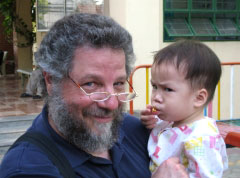
In talking about how his career took a course different from what he expected, he recalled, "In the early '80s, we started seeing these kids who were dying from diseases that they certainly should not have been dying from, and we quickly figured out that this was an immunodeficiency. When the first blood tests became available in the '80s, we were able to prove that they had HIV."
Although there was little that could be done at first to save these HIV-infected children, the development of effective antiretroviral agents changed the nature and the prognosis of the disease. Clinical investigators spent much of their time developing treatment and research protocols to best make use of these new agents, and children's lives were being saved.
"It wasn't until the early '90s that it became obvious that there was a much bigger problem going on in southern Africa than people had ever realized," Dr. LaRussa said. He was invited by a friend to give lectures on pediatric HIV care at the University of Zimbabwe in Harare, and while there he saw the extent of the problem first hand.
Dr. LaRussa remembered a trip that brought home the magnitude of the epidemic, a trip that had a huge impact on the direction of his career. "There's a particular orphanage that I visited in Zimbabwe," he said. "It was in a rural area. After you've been driving for two or three hours in the countryside, the first thing you see is all this white. You can't figure out what it is until you get close. It's all the little white crosses for the kids that have died. Nobody would dream that an orphanage would have a cemetery attached."
First WWO Trip: Vietnam, 2004
WWO held its first pediatric HIV training session at the Tam Binh orphanage in Ho Chi Minh City in May 2004. The week-long seminar was designed for the physicians providing care for the orphans, but anyone else involved in providing healthcare to HIV-infected children was invited, including people from the Vietnam Ministry of Health. Dr. LaRussa led the training, and he was accompanied by Ms. Jurgrau and Ouzama Nicholson, MD, a research fellow who will soon complete her training and go to Durban, South Africa to conduct research and provide clinical care for HIV-infected children. The trip was sponsored by a grant from Bristol-Myers Squibb.
Each morning, the Columbia team presented lectures on HIV medicine. "We started from the beginning with basics: HIV, pathogenesis, virology, all the way up through what drugs are available and the clinical manifestations, when to start antiretroviral therapy, what to expect once you do, how to manage complications -- we pretty much covered everything," Dr. LaRussa said. Each afternoon, the team examined the children, reviewed their clinical histories, and made recommendations for therapy once the drugs became available. "I think it was a shock for the physicians, because here we were, literally cramming 25 years of knowledge into five days of lectures, conferences, round-table discussions, and question-and-answer periods. It was clear we were going to have to come back at some point, once they had kids on therapy."
Ms. Jurgrau said, "Going to Vietnam and seeing children as ill as children had been in the early days of our epidemic here brought me back to that time. They're being thrown right on into it, and you can see that the medical people are going to make some of the same mistakes that we made years ago....It's a huge body of knowledge to try to get all at the same time. We've had more than 20 years to gain that knowledge."
The involvement did not stop with the end of the training week. Dr. LaRussa and his colleagues remain in touch with the Vietnamese physicians and provide consultation and advice about how best to care for the children. "We examined the clinical histories of all the HIV-infected kids at the orphanage and then made recommendations for therapy once the antiretrovirals came," Dr. LaRussa said. " We stay in contact with the docs there by email, and they tell us how things are going, and then we make recommendations."
Second WWO Trip: Ethiopia, 2005
Dr. LaRussa's next training trip for WWO was to Addis Ababa, Ethiopia, in April 2005. He took more people on this trip: two younger doctors from Columbia, Mark Foca, MD, and Natalie Neu, MD, who provide care for many HIV-infected children in New York City, as well as Dr. Ouzama Nicholson and another pediatric HIV nurse practitioner, Susan Vacca. The training was again focused on HIV-infected orphans, this time on those living at the AHOPE orphanage. HIV-infected children at this orphanage are treated at Barlow House, a clinic run by WWO.
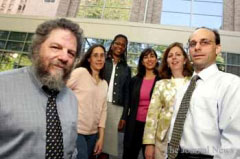
"We did a similar training exercise, but in a much more interactive way," Dr. LaRussa said. "We used all the pediatricians who came to the session to examine the kids, present the kids to the group, and then discuss what we would do as a group." More than 40 pediatricians attended the training. "That's about a quarter of all the registered pediatricians in Ethiopia," Dr. LaRussa said. "Again, we keep in touch with the doctors there who are caring for the kids. They send us email updates, and then we discuss it as a group and tell them what we think the next step should be." Dr. LaRussa and his colleagues plan to return to Addis Ababa in the fall of 2006.
Third WWO Trip: Back to Vietnam, 2006
Antiretroviral drugs were not available at the time of the first training session in Vietnam, so Dr. LaRussa knew his group would return once the drugs arrived, to provide a more practical training session. (Pediatric three-drug antiretroviral therapy has since been made available in Vietnam by the efforts of Dr. Jane Aronson and WWO, through the UNICEF procurement program, and support from the United States Agency for International Development will help maintain access to these drugs.) Once again, the sessions were opened up to include a wider audience of people providing healthcare to HIV-infected children.
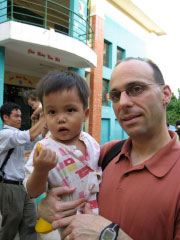
Because WWO has recently expanded its program in Vietnam to include two more orphanages, Ba Vi in the north near Hanoi and Vung Tau in the south, they decided to hold two one-week training sessions to reach healthcare workers in both parts of the country. Dr. Foca attended the first week in the south, and Dr. Neu and Ms. Jurgrau attended the second week in the north. Dr. LaRussa attended both weeks.
"It's a long trip," Dr. LaRussa said. "It took us a full 30 hours to go there and get back. You spend a day going there, you spend a day semi-recovering before you start lecturing, and then you need a day to get back. So three of those 14 days are involved in either travel or resting up."
"I don't do jet lag all that well," Ms. Jurgrau added. "This time I did really, really well going out there. The trip was so long going out, by the time I got there I was kind of on schedule. But it took me a whole week to recover when I got back."
They once again used an interactive structure for the training. "Lectures in the morning, and then in the afternoon for one of the sessions we went back to the orphanage, divided the attendees into groups, had them examine the available kids, and then come back to the group and present them and discuss what we think should be done," Dr. LaRussa said.
"We examined kids at an orphanage up north on one of the days we were there, and took pictures of them, because it helps us if we can put a picture on the file to recognize and remember them," Ms. Jurgrau said. "I was putting the pictures on the medical records I had made up for the kids, and it was difficult....Some of the kids were smiling, and some of the kids looked so sad. One of the children had very recently been abandoned at the orphanage...I just think about what it must be like for a family to be confronted with a diagnosis like that for a child, and know that they have absolutely no means to provide care for the child, and what that must be like for the family."
Different Points of View
The interactive structure used during the training sessions provides a beneficial model of care to the participants, because it highlights how often there is no single right answer or approach. "These discussions are very interesting, because not only are there a lot of subtleties in the care of these kids, but there are also situations where the answer is not that clear cut," Dr. LaRussa said.
"We like to tell them, 'Don't be afraid of questioning what other people are doing, because we often don't agree on what the management should be.' A lot of times in our weekly sessions, where we discuss patients here at Columbia, we argue out about what we think the pros and cons of the different approaches would be, and what would be the best for that particular patient. It's easy to figure out what the most virologically active regimen of therapy should be, but sometimes that's not the best regimen for the patient. It would not be a regimen the patient would be able to tolerate, or take in the manner that they have to take in order to make sure it is effective. A lot of times, it's good to turn these decisions over four or five times so that, by doing it with a group of people, you feel like you've covered all the bases and haven't neglected things."
"There are a lot of subtleties, not only in the medicine, but also figuring out what that particular person's going to do," he continued. "Sometimes I'll come up with an idea, and one of the nurses will say, 'Oh, no, that'll never work in this patient. And here are the five reasons.' And you have to say, "OK, you're the expert, you know them. Let's come up with plan B.'"
Each trip has included a nurse practitioner, for good reason. "Our nurse practitioners, who have the most intimate contact with the patients, are really the ones who are the best experts on what kids will take and what they won't," Dr. LaRussa said. "It's not like an adult, where you can say 'This is what you should do, and I strongly recommend that you do it,' and they either do or they don't. With kids, you have to worry about not only will they be able to take it -- can they swallow it? -- but also how sick they are, how competent are their caregivers if it's not in a controlled setting like an orphanage, whether the caregiver is too sick to actually care for the kids -- you're essentially thinking about providing therapy in the context of a family where there are a lot of other problems going on. That's where having the expertise of people that have been doing this for 20 or 25 years really helps."
Ms. Jurgrau agreed. "Over the years, I've seen many, many patients day to day, and have dealt with the minutiae. We're really good at the nitty gritty, because the science is fantastic, but if it's not practical, it's never going to work. Which is why a team approach to HIV care works, both here and anywhere else. It's a whole team approach."
Learning how to use the correct combinations of antiretrovirals is only the first part of long-term AIDS care, according to Dr. LaRussa. "As they get through the relatively easy part of this picture, which is getting people on therapy, they have a couple of years to learn how to deal with all the problems people are going to face. What happens when people feel well and they stop taking their drugs? This happens everywhere. Everybody wants antiretrovirals when they feel lousy, but a couple of years go by and they feel great, and now they're worried about side effects, or they don't want to take pills two or three times a day. Especially the adolescents, they decide, 'Why do I need to do this? I'm fine. I don't feel bad. I'll just stop taking them.' Or worse than that, they take them intermittently. So it's not like the problems are going to go away, they're just going to become different problems, and they're going to have to learn to deal with them, just the way we had to learn to deal with them."
Ms. Jurgrau added her perspective on the challenges of long-term care. "In New York right now, our big issue is kids who have been successfully treated for many years during childhood and are now adolescents. They are definitely interrupting their treatment. It's hard to reach them and to really get them to see what we see. Talk about resistance, talk about long-term issues, and it doesn't matter -- they all just want to be regular kids. Combine that with all the other developmental issues of adolescence, and put HIV in the mix, and you can see how adhering to a complicated medication regimen is next to impossible."
Opening the Eyes of Young Physicians
One of the benefits of bringing younger faculty on these training sessions is the exposure they get to the practice of medicine in resource-poor environments. "There are certainly different strains and pressures in the United States, but the reality is, physicians who are practicing in these poor countries are practicing under constraints that you have no idea how difficult it is," Dr. LaRussa said. "It reminds me what it was like when I started taking care of HIV-infected patients in the early '80s, where essentially you sat around and watched people die, and tried to figure out how to make them comfortable. That's certainly something I never want to go back to. And that's what these physicians have had to do."
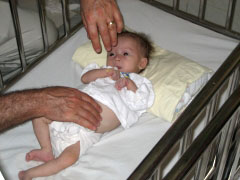
The contrasts between medical care in rich and poor countries can be eye-opening for those used to the United States. Dr. LaRussa said, "It's fun for me to watch young American physicians, who have practiced medicine in the most resource-rich environment in the world, have to sit and think and make decisions based on their clinical skills and not on the basis of multiple lab tests."
The range of diseases one sees also greatly differs between rich and poor countries. "They get to see diseases and presentations that you're not seeing a lot in the United States. Although we have tuberculosis, we have nowhere near the kind of problems that are present in southern Africa and Southeast Asia." These differences require that clinicians consider the impact of these diseases on HIV treatment.
It sometimes surprises Dr. LaRussa just how positive the experience has been for the physicians and nurses who have joined him during these international training weeks. "The three trips we've done have involved taking people who have very busy lives and schedules, who are trying to survive in a very competitive academic environment, and they're volunteering their time to oversee and help people in the situation where there is absolutely nothing for them to personally gain," he said. "They've got to make up the work they can't do while they're over there! They're not getting paid to do this, they're volunteering. Yet they're doing it out of the goodness of their hearts and the desire to help other people, and it's really been very gratifying to see the response."
Ms. Jurgrau concurred. "I think all of us, all the people in the HIV community who are doing this work, felt that that's where we could really make an impact," she said. "When the opportunity came up, there's not a person in my office who wasn't eager to participate and do this. It's exciting, too. We get plenty out of it, we get to travel to places we haven't been before, we get to feel like we're helping. There's a lot of secondary gain in feeling like you're really helping other people. . . . You spend years gaining this expertise, and then you want to put it to use."
"If anything, people are upset because not everybody can go on every trip," Dr. LaRussa continued. "Rather than saying, 'Don't bother me, I went last time, pick on somebody else,' people say, 'Are you sure I can't go on this trip? I would really like to go, I think it would be valuable if I could go and I could help out.' It's just a terrific thing to be able to see."
About the Author
Harry Goldhagen is the editor of Angels in Medicine.
About Angels in Medicine
Angels in Medicine is a volunteer site dedicated to the humanitarians, heroes, angels, and bodhisattvas of medicine. The site features physicians, nurses, physician assistants and other healthcare workers and volunteers who reach people without the resources or opportunities for quality care, such as teens, the poor, the incarcerated, the elderly, or those living in poor or war-torn regions. Read their stories at www.medangel.org.